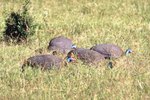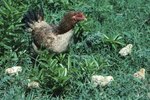Buff Orpingtons come out of their shell wearing the buff color they'll sport for life. Even males don't develop colored feathers like other breeds, and their short tails can make them hard to tell from females at first glance. Knowing a few subtle differences between the sexes can help you figure out who's who at any age.
Just Hatched
Subtle variations in down in the day-old chick can let you know your Buff Orpington's gender right from the start. Although both sexes sport buff-colored down, males have pale, whitish streaks in their down at the upper wing joints. Females may show faint brown lines on their backs and may have a brownish spot on their heads. At this age, there is little difference in their behavior that would reliably let you know which is male or female.
Vent sexing is another way of telling the gender of day-old chick. It involves gently pushing beneath the chick's vent to extrude the genitals. The technique is 98 percent accurate when done by a professional. A chick's genitals are easily injured at this age, so leave vent sexing to your veterinarian or other chicken professional.
Growing Up Chicken
Buff Orpington chicks may start showing sexual differences early in life. Males develop longer, thicker legs and stand taller than females. Some young roos stretch their necks and try to crow as early as 4 weeks old, although the sound is more chirp than cock-a-doodling at that age. Young roosters -- known as cockerels -- will begin to strut with their chest out. As young females approach the age where they can lay eggs, they'll squat in submission when a strutting cockerel approaches.
Becoming Hens and Roosters
Cockerels to Roosters
As males approach sexual maturity, they develop pointed cape feathers on their neck, shoulders and back. The male's tail isn't as showy as many breeds of roosters. Sickle-shaped feathers spill over his lower back and rump, but aren't iridescent or highly arched like the typical rooster tail. His comb and wattles become larger than those of the female and turn a bright red. A female's comb lies close to her head and her wattles are short and close to her neck. Both are a faded red.
Pullets to Hens
Buff Orpington pullets may start laying eggs as early as 5 months old and will deliver roughly 175 to 200 eggs each year. You'll hear the hens crooning rhythmically in unison as they set to work depositing their eggs. An excited cackle by the egg layer often concludes the job. A glance at the vent of a Buff Orpington of laying age will quickly tell you the gender. A hen's vent is large and round from passing eggs while a rooster's remains small. A laying hen will have a wider spread between her pubic bones than a rooster or juvenile chicken.
Writer Bio
Indulging her passion for vacation vagary through the written word on a full-time basis since 2010, travel funster Jodi Thornton-O'Connell guides readers to the unexpected, quirky, and awe-inspiring.




